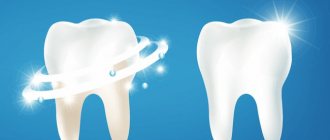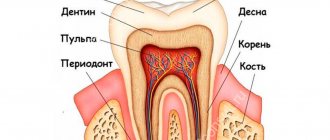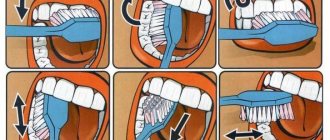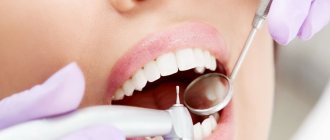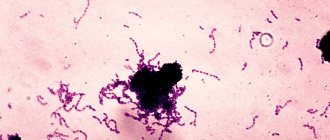Erosion of tooth enamel is a fairly common problem and, contrary to what many people believe, not harmless: in addition to the unpleasant cosmetic effect, the pathology negatively affects the condition of the teeth and requires immediate dental care.
In this article we will talk about the causes of erosion on teeth and the methods of solving the problem offered by modern dentistry.
Classification of tooth enamel erosion
Erosion of tooth enamel can last for years without causing much discomfort to a person. In other cases it may be very fleeting. In such a situation, tooth decay occurs within a few months and is almost impossible to eliminate.
Erosion is also distinguished by the degree of damage to the tooth. There are three stages:
- In the first, the lesion concerns only the top layer of enamel and is invisible to the naked eye. It does not cause any discomfort.
- At the second stage of erosion, the lesion reaches the deep layers of enamel, approaching the dentin. In this case, tooth hypersensitivity may occur, and the affected areas become noticeable.
- The third stage is characterized by damage to dentin, which is accompanied by discomfort and painful reactions to cold and other irritants. Clearly visible dents appear in places where erosion is localized.
The choice of treatment method directly depends on the stage of the disease. If in the initial stages minor conservative interventions are sufficient, then in later stages it is impossible to do without serious dental procedures.
Classification and stages of development of tooth enamel erosion in children
Depending on the depth of the lesion, three degrees of the disease are distinguished:
- initial: only the top layer is affected;
- medium: the pathological process involves the entire enamel;
- deep: destruction affects the upper layer of dentin.
The activity of the process allows us to distinguish two clinical stages of erosion development. In the active stage, relatively rapid destruction occurs: defects spread over the surface and become deeper. The enamel takes on a matte appearance, and in severe cases changes color to yellowish. In the stable phase, the teeth are not externally changed, there are no obvious symptoms, but when examined under a microscope, the lesion is clearly visible.
Causes of tooth erosion
Among the main causes of tooth enamel erosion are the following:
- chemical;
- mechanical;
- endocrine;
- external;
- physiological.
The first, that is, chemical causes of erosion, include the impact on tooth enamel of those substances that can cause its destruction. First of all, these are acids, which can be either natural or artificial. Often eating sour fruits, salads, generously sprinkled with vinegar, a person may not even suspect that his enamel is susceptible to destruction. The same effect is observed when consuming various sweets and drinks that are high in harmful acids.
Mechanical impact in most cases is associated with the wrong choice of toothbrush and toothpaste. Today the market is replete with teeth whitening products. Their main effect is to erase the top layer of enamel. If such impacts are excessive, the enamel will be worn to a critical state and erosive damage will occur, which will be further aggravated by other factors.
Endocrine causes include diseases of the thyroid gland. Such ailments negatively affect the condition of teeth in general and the quality of enamel in particular.
As for external factors, they are associated with work in hazardous industries, frequent stay in rooms where the emission of harmful gases and dust is abundant. The minerals that they contain negatively affect the entire body and contribute to the resolution of hard dental tissues.
Physiological causes can be various diseases of internal organs. The most dangerous diseases for enamel are diseases of the gastrointestinal tract. Their consequences are often the release of stomach acids into the oral cavity. This provokes the creation of a constant acidic environment, which gradually destroys the enamel.
Erosion on baby teeth
In children, the most common cause of the development of non-carious lesions is excessive consumption of liquids high in sugar and acids (milk and juice). Therefore, if the baby refuses to fall asleep without a bottle, it is better to pour regular water into it. It is also important to take care of oral hygiene: regularly cleaning them from bacterial plaque will help prevent the development of erosion on baby teeth.
Other problems that lead to erosion in children are crowded teeth and malocclusions.
Carefully monitor the condition of the tooth enamel in children, contact your dentist immediately when the first signs of the disease appear!
Symptoms of erosion
In the initial stages, enamel damage may go unnoticed. It is not visible externally, and it does not cause any pain or discomfort. However, if the disease is not treated, it begins to progress and then the first symptoms appear.
The surest sign of erosion is hypersensitivity of the tooth surface. Even if outwardly damage to the enamel surface is not visible, when exposed to cold or hot conditions, they make themselves felt.
If a person suspects that he has erosion, he can take a closer look at the surface of his teeth. The affected areas in most cases change color. Initially, in the early stages, they darken in comparison with the surface of the dentition. If the disease worsens, such localization areas acquire a white tint.
Stages and symptoms
- The enamel slowly loses its natural shade and shine. There are no obvious defects yet, but upon careful examination, the dentist can see changes in the structure.
- The area of pigmentation increases and the spots become noticeable. Teeth sensitivity increases and causes discomfort.
- The spots take on a yellow-brown tint. The enamel is deeply affected.
The disease is either active or stable. In the first case, the symptoms are pronounced - the color, structure and sensitivity of the enamel quickly change. In the second, the body itself tries to fight the problem and produces dentin to protect the damaged shell. Therefore, the patient does not experience pain for a long time.
Diagnosis of erosion
Tooth erosion can be detected at an early stage only by visiting a dentist. He will carry out special manipulations that will confirm the presence of a lesion and will distinguish it from caries.
A high-quality diagnosis by a specialist begins with a detailed examination of the oral cavity. It should be carried out under a microscope, since areas of erosion can be small. If the doctor has identified suspicions of enamel destruction, he conducts a special test. It is done using a special iodine mixture according to the following algorithm:
- First, the tooth surface is well dried;
- then iodine-containing substances are applied to the affected areas;
- wait half a minute.
If the cause of the lesion is indeed erosive destruction, the corresponding areas are painted bright yellow.
In the case when the erosion is at a later stage, the dentist is able to notice it when examining the teeth, then subsequent tests or other manipulations will not be required.
Main symptoms
When teeth are eroded, the enamel begins to suffer first. It loses its shine, changes shape and color: cup-shaped depressions appear on the surface of the tooth with yellow-brown spots. Over time, there is increased tooth sensitivity and pathological abrasion of the dentition. Note that this disease is more typical for adult patients, but recently it is quite common in young people from 18 to 25 years old. Researchers say that erosion most often affects women who have endocrine disorders associated with calcium metabolism.
Basic treatment methods
Erosion therapy should be comprehensive and depends on the degree of enamel damage. In the early stages, mineralization of the enamel will be sufficient. It will strengthen the surface of the tooth and relieve it from sensitivity. This procedure is carried out using special mixtures that are applied to the teeth. Calcium electrophoresis may also be prescribed at this stage.
To reinforce the result, the doctor may prescribe a special diet that will have a beneficial effect on dental health.
If the destruction of tooth enamel by erosion is at a later stage and is marked by the presence of serious symptoms, then restoration must be included in the course of treatment. It can be carried out using various methods. The first and simplest of them is the use of filling materials. They are applied in a similar way to the treatment of carious lesions. If the destruction is more extensive and deep, the doctor may recommend the use of veneers or metal-ceramic crowns. They will be able to completely cover the areas affected by erosion and return the teeth to a smooth surface. In this case, hypersensitivity completely disappears.
Important! Do not forget that often erosive tooth decay is a consequence of certain diseases of the internal organs. Therefore, for quality treatment it is necessary to conduct a comprehensive diagnosis and immediate treatment of somatic ailments.
Causes of the disease
Doctors have not yet established the exact factors causing this disease, since it can occur in almost any person, but experts have settled on the following options:
- Mechanical. Explains the manifestation of the disease by excessive mechanical stress placed on the teeth. For example, brushing your teeth with an excessively hard brush or using whitening abrasive paste or powder at home too often can scratch the tooth, which will lead to erosion;
- Chemical. Researchers who adhere to this theory cite exposure to foods with high levels of acidity on the enamel as the main causes of dental erosion;
- Endocrine. The concept is based on the results of studies that have found a relationship between erosion and hyperfunction of the thyroid gland. It is known that people suffering from thyrotoxicosis are twice as likely to visit the dentist due to dental erosion;
- Increased load on the dentition, when, with an incorrect bite or the absence of individual units, the chewing function is performed unevenly;
- Some medications can also cause enamel erosion as a side effect;
- In industries with metal or mineral dust, as well as when working with chemicals.
The causes of the disease can be determined more accurately with complex hardware diagnostics.
Prevention
Preventing tooth erosion is quite simple. First of all, it includes normalizing the diet. It is necessary to exclude from it those foods that can provoke an increase in acidity in the oral cavity. You should reduce the amount of vinegar, citric acid, etc. you consume.
To preserve the integrity of the enamel, it is recommended to reduce the amount of artificial dyes and acids in the diet. They are often included in candies, chewing gum, soda water, energy drinks, etc. It is better to give preference to natural sweets and drinks.
It is very important to choose the right toothbrush and toothpaste. Dentists recommend choosing brushes of medium hardness, which have special curves at the end of each bristle and do not injure tooth enamel. As for the paste, it should contain fluoride, which has a beneficial effect on strengthening the enamel. It is better to avoid toothpastes and oral care products that contain coarse abrasive particles. If you want to whiten your teeth, such products should be used no more than twice a week.
One of the main guarantees of maintaining the health of the oral cavity and tooth enamel in particular is systematic visits to the dentist. He will be able to promptly identify any damage to the tooth surface and prescribe high-quality treatment for erosion. This will avoid worsening the disease and the need for serious interventions.
Prognosis and prevention
With adequate treatment, tooth erosion becomes much smaller, and the enamel structure is restored. After severe symptoms disappear, children should visit the dentist regularly to prevent relapse. It is recommended to minimize the consumption of products that can increase the destruction of enamel.
Erosion of tooth enamel can occur even in a child. So that the baby does not experience pain when eating and does not feel embarrassed to smile, you need to consult a dentist in time. Experienced specialists at the SM-Doctor clinic will carry out all the necessary diagnostics and select the optimal way to restore the normal structure of the enamel.
Clinic doctors
Do you make these mistakes that destroy your enamel?
For our dentists, tooth enamel erosion is not just an external problem, but a serious disease, and therefore the attitude to treatment is no less serious.
There are several unobvious mistakes in daily hygiene that can cause erosion of tooth enamel and aggravate the disease. Continue reading the text on this page and find out how to prevent erosion and what to do if the enamel is already damaged.
Erosion of tooth enamel is not only a cosmetic defect, but also a rather serious disease. The doctors at the Dentabravo clinic will help you cope with this dental problem.
What is enamel erosion?
Enamel erosion is a common non-carious lesion of teeth. Externally it manifests itself in the form of round-shaped defects on the enamel surface. Sometimes tooth erosion is attributed to purely aesthetic defects, but this is completely wrong. Without timely treatment, it progresses quite quickly, increases in size and affects the deeper layers of dental tissue.
What are the causes of enamel erosion?
The etiology of this disease is not fully understood. Among the most likely causes of enamel erosion, dentists identify the following: 1) mechanical damage (due to the use of abrasive toothpastes); 2) chemical exposure (excessive consumption of food acids - sour fruits, marinades, carbonated drinks, etc.); 3) dysfunction of the endocrine system (in particular, diseases of the thyroid gland). The list of causes of tooth erosion can also include overload of enamel. Many people's mouths are missing teeth or have malocclusions. This is fraught with the fact that when chewing, the pressure is distributed incorrectly, and the cervical areas of overloaded teeth inevitably begin to collapse.
What are the types of enamel erosion?
Based on the intensity of the lesion and the depth of its focus, three types of erosion of hard dental tissues are distinguished. At the first stage, only the surface layers of enamel are destroyed. At the second stage of the disease, the entire thickness of the enamel is involved in the pathological process. In the third, deepest degree of erosion, damage affects dentin.
What are the symptoms of enamel erosion?
At an early stage, tooth erosion appears as a slight tarnishing of the enamel. At later stages of the development of the disease, painful sensations arise from thermal and chemical irritants, and small oval or round depressions with a smooth and shiny bottom appear on the surface of the enamel. Typically, dental erosion affects two symmetrically located teeth. Usually the disease is protracted, slowly progressing over 8 to 12 years, and sometimes more. This length of time is explained by the fact that the process of gradual destruction of dental tissue can be active, or it can take place in a stable manner. With the active development of erosion of the hard tissues of the tooth, the patient feels more discomfort and consults a doctor more often. Patients with a “stable” course of the disease may not notice it for a long time and not go to the doctor.
What are the treatments for enamel erosion?
At the initial stage of development of the disease, a course of remineralizing therapy is prescribed - calcium and fluoride preparations are applied to the damaged enamel. At a later stage, treatment of tooth enamel erosion, in addition to remineralization, involves FILLING the defect with composite materials. In advanced forms of the disease and the presence of significant lesions, it is recommended to restore teeth using VENEERS or artificial CROWNS.
What are the criteria for quality of treatment?
For minor damage to the enamel, treatment can be considered successful if the erosions are smoothed out, become almost invisible, and the patient’s painful reactions to thermal and chemical irritants disappear. In cases where filling is required, it is necessary to achieve a tight fit between the edges of the fillings in order to ensure a sufficiently long service life of the restoration.
What are the methods for preventing enamel erosion?
Following some simple rules will help minimize the risk of developing enamel erosion. It is necessary to 1) replace too hard toothbrushes with softer options, 2) use whitening and abrasive toothpastes less often, 3) stop consuming juices and carbonated drinks, or at least drink them through a straw, 4) rinse your mouth with water after eating, and better with special antibacterial solutions. You can strengthen tooth enamel and prevent erosion of hard tooth tissues using fluoride-containing toothpastes.
What is the cost of treating enamel erosion?
The cost of dental services for enamel erosion varies significantly depending on the stage of the disease and the chosen treatment method. You can see approximate prices at the Dentabravo clinic in the price list or table below. You can make an appointment for an initial appointment by clicking on the appropriate button. The specialist will conduct an examination, determine the causes of tooth erosion and select the optimal treatment option.
